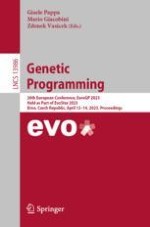2023 | OriginalPaper | Chapter
All You Need is Sex for Diversity
Authors : José Maria Simões, Nuno Lourenço, Penousal Machado
Published in: Genetic Programming
Publisher: Springer Nature Switzerland
Activate our intelligent search to find suitable subject content or patents.
Select sections of text to find matching patents with Artificial Intelligence. powered by
Select sections of text to find additional relevant content using AI-assisted search. powered by
